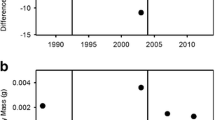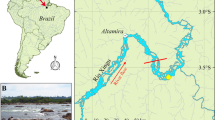Abstract
Trophic adaptability is a term used to describe feeding flexibility in fishes. Though a useful conceptual starting point, fishes often face constraints on their ability to switch prey that could limit feeding success even when prey switching is observed. We compared striped bass diet compositions summarized from previously published studies in California’s Sacramento-San Joaquin Delta during two time periods (1963–1964 and 2001–2003), which allowed us to evaluate trophic adaptability in San Francisco Estuary striped bass at multiple time scales, ranging from intra-annual to multidecadal. The Delta is the landward region of the San Francisco Estuary; over time between the study periods, the Delta underwent substantial changes in potential prey availability for striped bass. We found evidence for trophic adaptability in San Francisco Estuary (SFE) striped bass at all temporal scales examined. Despite this ability to adapt to changes in prey availability, the relative abundance and carrying capacity of young striped bass have declined. This decline has previously been associated with substantial declines in their dominant historical prey—mysid shrimp. Our results, coupled with these previous findings, indicate that trophic adaptability may have limited usefulness as a conceptual model to predict foraging success when other food web constraints are not considered. We speculate that this is particularly true in highly invaded ecosystems like the San Francisco Estuary because invading species often introduce substantial and permanent changes into food webs, decreasing the likelihood that a predator will find prey assemblages that fully replace historical prey assemblages.




Similar content being viewed by others
References
Alpine AE, Cloern JE (1992) Trophic interactions and direct physical effects control phytoplankton biomass and production in an estuary. Limnol Oceanogr 37:946–955
Baxter CV, Fausch KD, Murakami M, Chapman PL (2004) Fish invasion restructures stream and forest food webs by interrupting reciprocal prey subsidies. Ecology 85:2656–2663 DOI 10.1890/04-138
Bennett WA, Ostrach DJ, Hinton DE (1995) Larval striped bass condition in a drought-stricken estuary: evaluating pelagic food-web limitation. Ecol Appl 5:680–692 doi:10.2307/1941977
Bryant ME, Arnold JD (2007) Diets of age-0 striped bass in the San Francisco Estuary, 1973–2002. Calif Fish Game 93:1–22
Buckel JA, Stoner AW (2004) Negative effects of increasing group size on foraging in two estuarine piscivores. J Exp Mar Biol Ecol 307:183–196 doi:10.1016/j.jembe.2004.02.003
Daniels RA, Limburg KE, Schmidt RE, Strayer DL, Chambers RC (2005) Changes in fish assemblages in the tidal Hudson River, New York. Am Fish Soc Symp 45:471–503
Feyrer F, Herbold B, Matern SA, Moyle PB (2003) Dietary shifts in a stressed fish assemblage: consequences of a bivalve invasion in the San Francisco Estuary. Environ Biol Fishes 67:277–288 doi:10.1023/A:1025839132274
Feyrer F, Nobriga ML, Sommer TR (2007) Multidecadal trends in three declining fish species: habitat patterns and mechanisms in the San Francisco Estuary, California, USA. Can J Fish Aquat Sci 64:723–734 doi:10.1139/F07-048
Gerking SD (1994) Feeding ecology of fish. Academic, San Diego
Hartman KJ, Brandt SB (1995) Trophic resource partitioning, diets, and growth of sympatric estuarine predators. Trans Am Fish Soc 124:520–537 doi:10.1577/1548-8659(1995)124<0520:TRPDAG>2.3.CO;2
Hartman KJ, Margraf FJ (2003) US Atlantic coast striped bass: issues with a recovered population. Fish Manag Ecol 10:309–312 doi:10.1046/j.1365-2400.2003.00361.x
Johnson JH, Dropkin DS (1992) Predation on recently released larval American shad in the Susquehanna River basin. N Am J Fish Manage 12:504–508 doi:10.1577/1548-8675(1992)012<0504:PORRLA>2.3.CO;2
Jordan RC, Howe DV, Hurst TP, Juanes F (2003) Feeding habits of age-0 striped bass, Morone saxatilis, in the mid-Hudson River Estuary: temporal, spatial, and ontogenetic variation. Estuaries 26:1486–1493
Kimmerer WJ (2002) Physical, biological, and management responses to variable freshwater flow into the San Francisco Estuary. Estuaries 25:1275–1290
Kimmerer WJ (2006) Response of anchovies dampens effects of the invasive bivalve Corbula amurensis on the San Francisco Estuary foodweb. Mar Ecol Prog Ser 324:207–218 doi:10.3354/meps324207
Kimmerer WJ, Cowan JH Jr, Miller LW, Rose KA (2000) Analysis of an estuarine striped bass (Morone saxatilis) population: influence of density-dependent mortality between metamorphosis and recruitment. Can J Fish Aquat Sci 57:478–486 doi:10.1139/cjfas-57-2-478
Mittelbach GG, Persson L (1998) The ontogeny of piscivory and its ecological consequences. Can J Fish Aquat Sci 55:1454–1465 doi:10.1139/cjfas-55-6-1454
Mittelbach GG, Turner AM, Hall DJ, Rettig JE (1995) Perturbation and resilience: a long-term, whole-lake study of predator extinction and reintroduction. Ecology 76:2347–2360 doi:10.2307/2265812
Moyle PB (2002) Inland fishes of California, revised and expanded. University of California Press
Nobriga ML, Feyrer F (2007) Shallow-water piscivore-prey dynamics in California’s Sacramento-San Joaquin Delta. San Francisco Estuary and Watershed Science 5:http://repositories.cdlib.org/jmie/sfews/vol5/iss2/art4
Nobriga ML, Feyrer F, Baxter RD, Chotkowski M (2005) Fish community ecology in an altered river delta: spatial patterns in species composition, life history strategies, and biomass. Estuaries 28:776–785
Orsi JJ, Mecum WL (1996) Food limitation as the probable cause of a long-term decline in the abundance of Neomysis mercedis the oppossum shrimp in the Sacramento-San Joaquin estuary. In: Hollibaugh JT (ed) San Francisco Bay: the ecosystem. American Association for the Advancement of Science, San Francisco, pp 375–401
Rahel FJ, Stein RA (1988) Complex predator–prey interactions and predator intimidation among crayfish, piscivorous fish, and small benthic fish. Oecologia 75:94–98 doi:10.1007/BF00378819
Reimchen TE (2000) Predator handling failures of lateral plate morphs in Gasterosteus aculeatus: functional implications for the ancestral plate condition. Behaviour 137:1081–1096 doi:10.1163/156853900502448
Robertson DR (1987) Responses of two coral reef toadfishes (Batrichoididae) to the demise of their primary prey, the sea urchin Diadema antillarum. Copeia 1987:637–642 doi:10.2307/1445655
Sommer T, Armor C, Baxter R, Breuer R, Brown L, Chotkowski M et al (2007) The collapse of pelagic fishes in the upper San Francisco Estuary. Fisheries 32(6):270–277
Stevens DE (1966) Food habits of striped bass, Roccus saxatilis, in the Sacramento-San Joaquin Delta. In: Turner JL, Kelley DW (eds) Ecological studies of the Sacramento-San Joaquin Delta, part II, fishes of the Delta. California Department of Fish and Game Fish Bulletin 136, pp 68–96
Stevens DE, Kohlhorst DW, Miller LW, Kelley DW (1985) The decline of striped bass in the Sacramento-San Joaquin Estuary, California. Trans Am Fish Soc 114:12–30 doi:10.1577/1548-8659(1985)114<12:TDOSBI>2.0.CO;2
Uphoff JH Jr (2003) Predator–prey analysis of striped bass and Atlantic menhaden in upper Chesapeake Bay. Fish Manag Ecol 10:313–322 doi:10.1046/j.1365-2400.2003.00366.x
Vanderploeg HA, Nalepa TF, Jude DJ, Mills EL, Holeck KT, Liebig JR et al (2002) Dispersal and emerging ecological impacts of Ponto-Caspian species in the Laurentian Great Lakes. Can J Fish Aquat Sci 59:1209–1228 doi:10.1139/f02-087
Venturelli PA, Tonn WM (2006) Diet and growth of northern pike in the absence of prey fishes: initial consequences for persisting in disturbance-prone lakes. Trans Am Fish Soc 135:1512–1522 doi:10.1577/T05-228.1
Walter JF III, Overton AS, Ferry KH, Mather ME (2003) Atlantic coast feeding habits of striped bass: a synthesis supporting a coast-wide understanding of trophic biology. Fish Manag Ecol 10:349–360 doi:10.1046/j.1365-2400.2003.00373.x
Acknowledgements
This study was conducted under the auspices of the Interagency Ecological Program for the San Francisco Estuary (IEP). B. McDonnell, S. Ford, Z. Hymanson, T. Sommer, P. Hergessell, C. Armor, R. Baxter, and M. Chotkowski facilitated IEP support. We thank numerous additional staff from the California Departments of Water Resources and Fish and Game for assistance with field and laboratory work. Comments by T. Sommer and L. Brown improved the manuscript prior to its submission. Comments by two anonymous reviewers greatly improved the submitted manuscript.
Author information
Authors and Affiliations
Corresponding author
Rights and permissions
About this article
Cite this article
Nobriga, M.L., Feyrer, F. Diet composition in San Francisco Estuary striped bass: does trophic adaptability have its limits?. Environ Biol Fish 83, 495–503 (2008). https://doi.org/10.1007/s10641-008-9376-0
Received:
Accepted:
Published:
Issue Date:
DOI: https://doi.org/10.1007/s10641-008-9376-0




